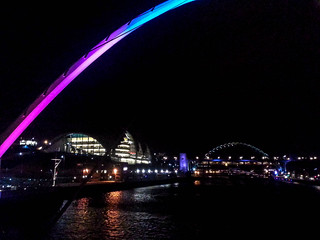In Newcastle again over the last couple of days for another multi-purpose city break. The real reason for going was that we were marking Marion’s birthday by going to see Ludovico Einaudi performing his latest work “In a time lapse” (example here on his YouTube channel) at the Sage in Gateshead. Add into that some present shopping, a quick trip to the Laing, Baltic Mill and Side gallery and we had a recipe for a busy but enjoyable couple of days.
I’ll leave comment on the concert for others except to say that I enjoyed it very much and that I expect it to be a bit of a contrast to the Black Sabbath concert I bought tickets for in the afternoon!!

The Laing was majoring in its print adverts around town on its display from the Newlyn school which was very pleasant, but didn’t really catch my eye – probably because I’m not a painter. What did catch my eye however was Timecasting by Nick Kennedy – a clever idea which involved attaching pencil leads to wire cradles attached to the second hands of 81 clock mechanisms arranged in a grid on individual pieces of paper and letting them mark patterns as they ran. The blurb suggested that it “can be seen as an experiment in recording time and making it visible through a mechanised drawing process” which is arguably true of any artistic process which does not instantaneously capture an image or represent a single instance in time. I was more intrigued by the alternative premise in the blurb, namely that the process reveals “order from apparent chaotic movement.” Each circular trace – which was reminiscent of spirograph traces of old – showed clear evidence of the 60 ticks per minute being traced by the second hand. Although the little wire cradles bounced erratically at every move, it was clear that there was a pattern to their action.
The following day we kicked off with the Baltic, which was showing 4 different artists – one on each floor. On the top floor Fabric Hyber was showing a series of installations which appeared to me to be about the workings of the environment and mans attempts to control and exploit it – although I should say that nothing in any of the provided statements suggested this – or indeed anything very helpful except to indicate that interacting with the exhibits was to be expected. Unlike Adrian Searle in the Guardian I found it interesting and thought provoking – and it provided some slapstick amusement as well, with a series of sheds that had a couple of surprises in store as you opened the doors. If you’re in or around Newcastle I think it’s worth a visit.
Sadly I couldn’t say the same for the next two floors – a series of installations by David Maljkovic on one and David Jablonowski on the next down. In both cases I could have used an interpreter to help me get something from them. There is a handy little video here which helps (a bit) with the latter, although I think the analogy between concrete/polystyrene blocks and data on the internet is stretching credulity to some degree. Move on – I can’t enjoy/understand/empathise with everything.
The ground floor featured a series of paintings by Marcin Maciejowski re-presenting found images which appeared to question the relationship between painting and photography and examine more closely the purpose of both. Plenty of examples on Google if you want a flavour. I thought the upper image on this page was particularly provoking. I can imagine in the original that it was a series of pictures of wannabe starlets on the red carpet at some showbiz event, but in re-interpreting it he has changed the emphasis to their clothing – recasting them as coat hangers for the fashion industry. All that is – except one couple – who are apparently oblivious to the camera and so to some degree retain their humanity and distance from the marketing machine represented by the other images. But again – that’s just my interpretation – I make no claims for its “correctness”.
Final visit of the day was to Side Gallery which was showing a series by Patrice Terraz on the living conditions of abandoned seafarers. A mix of portraits and location detail shots the series admirably catches the mix of despair, stoicism and hope that must be felt by these individuals trapped in foreign ports by ship owners who can’t or wont pay their wages – and often wont even provide for their basic needs. It had the potential be be another misery tourism piece, but Terraz rises well above that, allowing his subjects to retain a sense of human dignity. These were very real people – in very difficult circumstances, yes – but people not victims. It seems to me that good documentary work – like this - does not forget that. See it if you can.
No comments:
Post a Comment